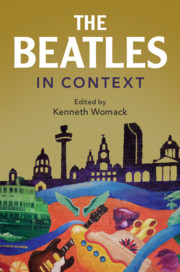Book contents
- The Beatles in Context
- Composers In Context
- The Beatles in Context
- Copyright page
- Contents
- Illustrations
- Contributors
- Preface
- Acknowledgments
- Chronology
- Part I Beatle People and Beatle Places
- Part II The Beatles in Performance
- Part III The Beatles on TV, Film, and the Internet
- Chapter 10 From Juke Box Jury to The Ed Sullivan Show: Radio and TV – the Beatles’ “Star-Making Machinery”
- Chapter 11 Projecting the Visuality of the Beatles: A Hard Day’s Night and Help!
- Chapter 12 Beatletoons: Moxie, Music, and the Media
- Chapter 13 Documentary, Rockumentary: Let It Be and the Rooftop Concert
- Chapter 14 The Beatles Redux: The Anthology Series and the Video Age
- Chapter 15 Pop Goes the Internet
- Part IV The Beatles’ Sound
- Part V The Beatles as Sociocultural and Political Touchstones
- Part VI The Beatles’ Critical Reception and Cultural Legacy
- Further Reading
- Index
Chapter 11 - Projecting the Visuality of the Beatles: A Hard Day’s Night and Help!
from Part III - The Beatles on TV, Film, and the Internet
Published online by Cambridge University Press: 10 January 2020
- The Beatles in Context
- Composers In Context
- The Beatles in Context
- Copyright page
- Contents
- Illustrations
- Contributors
- Preface
- Acknowledgments
- Chronology
- Part I Beatle People and Beatle Places
- Part II The Beatles in Performance
- Part III The Beatles on TV, Film, and the Internet
- Chapter 10 From Juke Box Jury to The Ed Sullivan Show: Radio and TV – the Beatles’ “Star-Making Machinery”
- Chapter 11 Projecting the Visuality of the Beatles: A Hard Day’s Night and Help!
- Chapter 12 Beatletoons: Moxie, Music, and the Media
- Chapter 13 Documentary, Rockumentary: Let It Be and the Rooftop Concert
- Chapter 14 The Beatles Redux: The Anthology Series and the Video Age
- Chapter 15 Pop Goes the Internet
- Part IV The Beatles’ Sound
- Part V The Beatles as Sociocultural and Political Touchstones
- Part VI The Beatles’ Critical Reception and Cultural Legacy
- Further Reading
- Index
Summary
In our increasingly mediated visual culture, we have acquired a tendency to see before we listen. And looking back on the evolution of the Beatles as a serious topic for cultural study, it is fair to say American university visual arts courses, at least, recognized Beatles films for their own sake before the group’s musical contributions to popular culture were deemed worthy of academic attention. Even the critically denounced Magical Mystery Tour (1967), on campuses, was treated as an important cultural product or as “art” beyond any entertainment value (or dearth thereof). But such recognition really begins with the Beatles’ first two filmic endeavors, A Hard Day’s Night (1964) and Help! (1965), which, taken together, anticipate the mid-1960s seismic shift from Beatlemania to the Beatles as a Gesamtkunstwerk or, rather, from an outlet for “incorrigible” teenagers to the irrefutable, all-encompassing voice for an entire generation of progressive-minded young adults on both sides of the Atlantic – and around the world. But this “voice” was cinematically seen in these films before it was musically heard on forthcoming albums, namely Rubber Soul, Revolver, and, of course, Sgt. Pepper’s.
Information
- Type
- Chapter
- Information
- The Beatles in Context , pp. 125 - 133Publisher: Cambridge University PressPrint publication year: 2020
